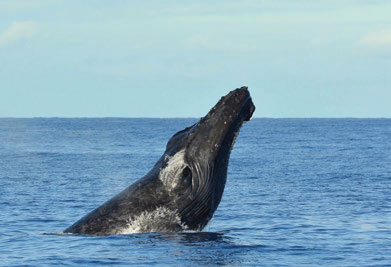One of the best ways to learn more about and watch the whales more closely is through a whale watch cruise, offered at Waikoloa Beach Resort by Ocean Sports (hawaiioceansports.com), a company that has been working in Hawai`i since 1981. We asked Claire Muchin, a consultant and naturalist on the Ocean Sports boats, to share some insights on the humpbacks.
NAUPAKA NEWS: The whales are late arriving in Hawai`i this year … what would cause that?
MUCHIN: Researchers aren’t sure. Some posit that the water stayed warmer longer in the northern areas where the whales feed, so they stayed longer to take advantage of the available calories. Others theorize that the whales migrated on their “normal” schedule, but stayed further offshore when they got to the main Hawaiian Islands because the coastal waters were “uncomfortably warm.”
NN: Does that also mean they will be staying longer than usual?
MUCHIN:The whales migrate to Hawai`i just to mate, calve, and take care of calves. As soon as they’re able to accomplish the particular task they came here to do, they’ll most likely leave (to get back to the food). We’ll know more sometime in May!
NN: Describe the migration … where do the whales go, and when?
MUCHIN:The humpbacks that come to Hawai`i are part of the North Pacific population (there are 11 distinct populations who live in each of the world’s oceans). Of the approximately 20,000 – 22,000 North Pacific Humpbacks, about two-thirds come to Hawai`i. (The rest migrate to waters off of Baja California or the Southern Islands of Japan). For the most part, the humpbacks that come to Hawai`i migrate directly north and spend their summers off the coast of Alaska (from the Gulf of Alaska to the Aleutian Islands). Migration to Hawai`i from Alaska begins in autumn. Interestingly, individual humpbacks will not spend an entire winter here. They may spend as little as two weeks here before heading back … and if a female mates successfully on the way to Hawai`i, she may turn around and swim back to Alaska without even reaching the islands.
NN: We most often think of humpbacks as the primary species frequenting Hawaiian waters, but there are several other species also, correct?
MUCHIN:Humpbacks are the whales who migrate here, but as many as 18 different species of cetaceans live around the islands year-round. We encounter some of them frequently (like spinner dolphins), though most of the others live in deeper water (like sperm whales). But we do see some species like melon head whales, spotted dolphins, false killer whales, and pilot whales on occasion in the coastal waters.
NN: Climate change and warming seas are (pardon the pun) hot topics … how do these phenomena affect the humpbacks’ migration patterns?
MUCHIN:We’re not really sure. Climate change may have had something to do with the later arrival of the whales this year … but we did start seeing them frequently on our charters by December 15th. Up until about four years ago, we didn’t even begin operating whale watch charters until that date because the whales hadn’t arrived until then. So actually, the earlier arrival of the humpbacks the past couple of years may have been the aberration … and what we saw this year may have been the norm.
NN: How do those same conditions affect the health of the whales and their food sources generally?
MUCHIN: That’s a complex question with a complex answer. Many of the small prey fish (like herrings and anchovies) have been schooling nearer to shore in the past year, so that’s where the whales have been found. Everything in the ocean is interrelated.
NN: What are some of the other risks to the whale population these days? Navy sonar? Hunting? Ocean trash/plastics?
MUCHIN: All of the above. Also ship strikes, since the humpback population has increased, more whales are swimming in the shipping lanes. Big ships (like cargo ships) don’t often see the whales and have run into them.
NN: What are some of the main messages you try to get across to visitors on a whale watching cruise?
MUCHIN: We try to get our guests involved in the excitement of seeing the humpbacks and sharing the ocean with them. We’ve found that humpbacks themselves are the ones sharing the important messages.

